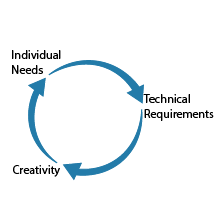Teaching Philosophy
My teaching philosophy consists of three main components:
- meeting the needs of the individual
- mastering the instrument (technical requirements)
- applying musicianship/creativity through historical and theoretical application.
My philosophy in teaching is to introduce these elements in a synchronized fashion

Individual needs
Applied teaching requires an understanding of each student’s strengths and weaknesses. Students enter music with a wide range of knowledge, training and performance experience. The individual needs of each student must be determined as soon as possible and formulated into a long-term plan.
Technical Requirements
The physical aspect of playing the cello is demanding. The right and left hand are functioning in a different manner and require precise coordination. Intonation is perhaps one of the most difficult elements to master in string playing. Students must develop a physical sense of spacing and timing of the instrument. This requires trust in one’s physical sense of measurement.
Musicianship/Creativity
The technical requirements of playing the cello are a means to a musical performance. One must also have a knowledge of musical styles from a historical perspective as well as a theoretical knowledge of musical structure. Having had master teachers and extensive performance experience, my goal in teaching is to suggest a musical interpretation at the outset and attempt to reach the highest level of a performance with this in mind.
Coming full circle, creativity requires that I allow students to experiment to some degree with various musical interpretations, in an attempt to allow them to discover and create without interference, therefore, meeting the needs of the individual. The process of discovery is, from my point of view, important, as it necessary for individual expression and growth.


